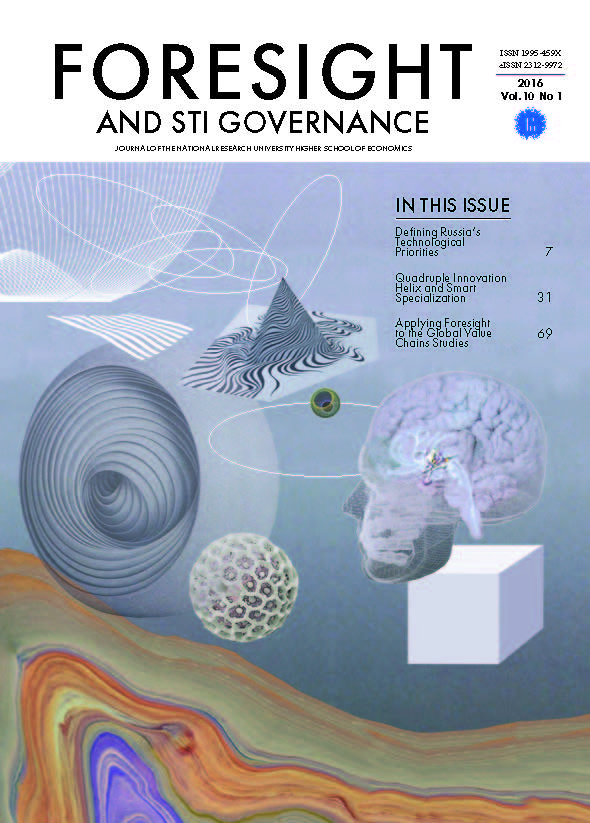Abstract
The paper suggests a model for verifying ways to identify scientific-technological priorities in Russia and suggests instruments for their implementation and correction. Our model for the identification of priorities is based on Russia’s socio-economic development goals, and takes into account the impact of different scientific and technological development scenarios on the implementation of models of socio-economic arrangement. Based on this logic, a group of technological priorities invariant to the wider spectrum of national economic and social goals is suggested.World economic, social, and scientific-technological trends and their Russian projections are taken as exogenous factors for choosing technological priorities. The suggested approach is based on the assumption that a new system of priorities should ensure support for implementing strategic development goals and tasks in the medium- and long term, and aims to help define these goals and tasks more accurately.As a result, the paper identifies two groups of priorities. The first group outlines the already institutionalized directions of technological development while the second group outlines directions for institutionalization in the near future. The suggested logic is illustrated through analysis of five world trends and their applications in Russia, and we highlight which technologies will be driven by these global trends.References
Berger S. (2013) Making in America. From innovation to market. Cambridge, MA: MIT Press.
Coates V., Farooque M., Klavans R., Lapid K., Linstone H.A., Pistorius C., Porter A.L. (2002) On the Future of Technological Forecasting//Technological Forecasting and Social Change. Vol. 67. № 1. P. 1-17.
Cuhls K., Kuwahara T. (1994) Outlook for Japanese and German Future Technology: Comparing Technology Forecast Surveys. Heidelberg: Physica-Verlag.
Irvine J.M., Martin B.R. (1984) Foresight in Science: Picking the Winners. London: Pinter.
Lane N., Kalil T. (2005) The National Nanotechnology Initiative: Present at the Creation//Issues in Science and Technology. Summer 2005. P. 49-55.
Martin B.R. (2010) The Origins of the Concept of “Foresight” in Science and Technology: An Insider's Perspective//Technological Forecasting and Social Change. Vol. 77. № 9. P. 1438-1447.
National Photonics Initiative (2013) Lighting the Path to a Competitive Secure Future. Режим доступа: http://spie.org/Documents/AboutSPIE/NPI_Launch_Slides_23_May_2013.pdf, дата обращения 24.06.2014.
National Research Council (1998) Harnessing Light: Optical Science and Engineering for the 21st Century. Washington, D.C.: National Academy Press.
Perez С. (2002) Technological Revolutions and Financial Capital: The Dynamics of Bubbles and Golden Ages. London: Edward Elgar.
Wagner C., Popper S. (2003) Identifying critical technologies in the United States: A review of the federal effort//Journal of Forecasting. № 22 (2/3). P. 113-128.
Бестужев-Лада И.В. (1982) Рабочая книга по прогнозированию. М.: Мысль.
Гапоненко Н.В. (2008) Форсайт: теория, методология, опыт. М.: ЮНИТИ-ДАНА.
Гапоненко Н.В. (ред.) (2006) Нанотехнологии: Форсайт. М.: Современная экономика и право.
Глазьев С.Ю. (1993) Теория долгосрочного технико-экономического развития. М.: Владар.
Гохберг Л.М. (ред.) (2014) Прогноз научно-технологического развития России. М.: Министерство образования и науки РФ, Национальный исследовательский университет «Высшая школа экономики».
Гохберг Л.М., Филиппов С.П. (ред.) (2014) Прогноз научно-технологического развития России: 2030. Энергоэффективность и энергосбережение. М.: Министерство образования и науки РФ, Национальный исследовательский университет «Высшая школа экономики».
Дежина И., Пономарев А. (2014) Перспективные производственные технологии: новые акценты в развитии промышленности//Форсайт. Т. 8. № 2. С. 16-29.
Дежина И., Пономарев А., Фролов А. (2015) Перспективные производственные технологии в России: контуры новой политики//Форсайт. Т. 9. № 1. С. 20-31.
Дынкин А.А. (ред.) (2011) Стратегический глобальный прогноз 2030. Расширенный вариант. М.: Магистр.
Иванов В.В. (2015) Инновационная парадигма XXI. М.: Наука.
НИУ ВШЭ (2014) Индикаторы науки: 2014. Статистический сборник. М.: НИУ ВШЭ.
Смирнов С. (2013) Какая наука нам нужна: мнение академиков//Наука и жизнь, 09.04.2013. Режим доступа: http://www.nkj.ru/news/21988/, дата обращения 24.06.2015.

This work is licensed under a Creative Commons Attribution 4.0 International License.

